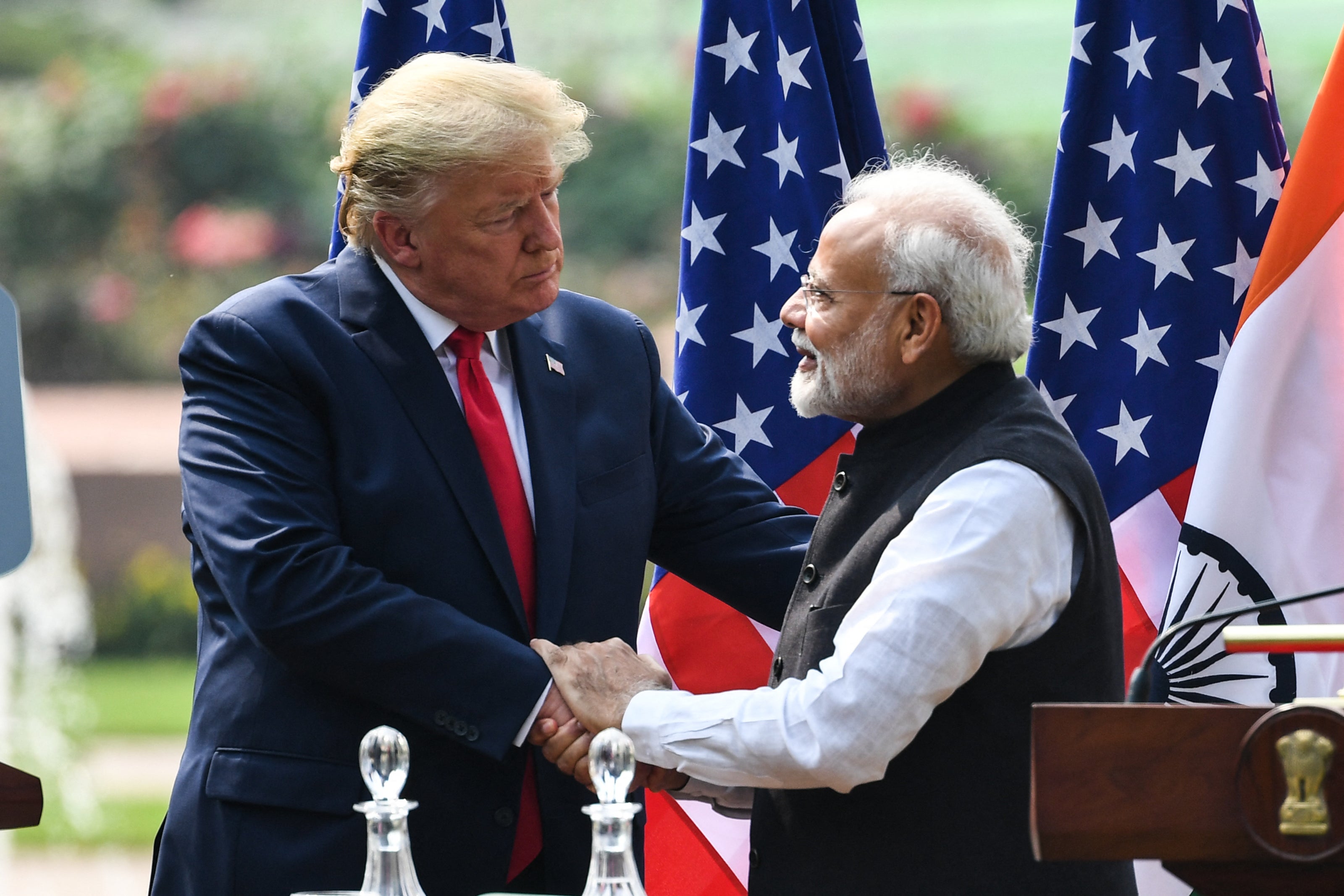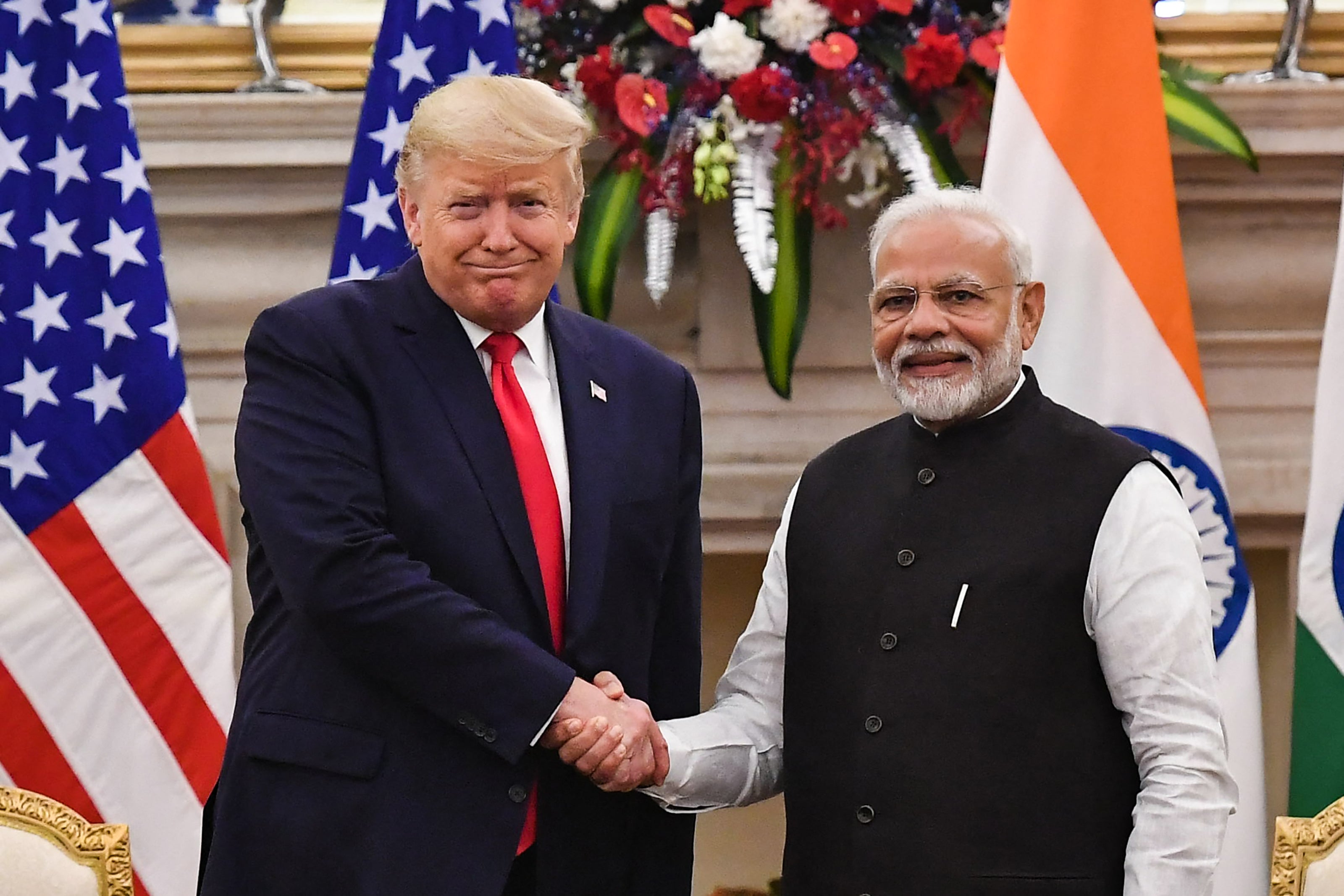Prime minister Narendra Modi will meet his “friend” Donald Trump in Washington on Thursday as India prepares to further cut levies on American goods to escape the American president’s salvo of tariffs.
Mr Modi’s trip to the US comes amid growing anger in India over the humiliating deportation by the US of over a 100 undocumented Indian migrants last week.
Foreign policy experts believe that Mr Modi and Mr Trump will talk immigration, trade, and arms sales. China is also set to be on the agenda as Mr Trump looks to India to help counter the Asian giant.
Mr Modi’s government is reportedly preparing additional tariff cuts on at least dozen sectors, from electronics to medical and surgical equipment, ahead of his meeting with Mr Trump, a move that could boost US exports to India and avoid a potential trade war.
Mr Trump, in his second term, wants more from India. He has called Mr Modi a “great leader” and last week said they were “committed to a mutually beneficial and trusted partnership” but in the past did not shy away from criticising New Delhi for charging excessive tariffs – even calling the country a “tariff king”.

The president emphasised the importance of “moving towards a fair bilateral trade relationship” during a phone call with Mr Modi last week, a White House readout said.
India, on its part, has sought to avoid a trade war with its biggest trading partner by already imposing pre-emptive tariff cuts.
Two-way trade exceeded $118bn (£94bn) in fiscal 2023-2024, with India posting a surplus of $32bn (£25bn).
For the two leaders, who developed a strong bonhomie during Mr Trump’s first presidency, just one meeting could potentially define the future of bilateral relations between the US and India.
“I look forward to meeting my friend president Trump,” Mr Modi said in a statement on Monday before leaving for France and the US. “This visit will be an opportunity to build upon the successes of our collaboration in his first term and develop an agenda to further elevate and deepen our partnership, including in the areas of technology, trade, defence, energy, and supply chain resilience,” he said.
Just days after Mr Trump’s inauguration, the Indian commerce ministry reduced levies on heavyweight bikes with engines above 1,600cc from 50 per cent to 30 per cent and on smaller models to 40 per cent, complying with the American president’s longstanding demand to reduce import taxes on high-end motorcycles like the Harley Davidson.
But New Delhi is still anxious over the American president’s hawkish outlook on Brics, a group of major economies that includes India and China. Mr Trump has begun his second presidency by launching a trade war with China. The two countries have announced tit-for-tat levies on a range of goods in recent days.
The US president has also threatened to hit Brics with 100 per cent tariffs if they attempt to introduce an alternative currency to the dollar.
“Since tariffs are important for the Trump administration, India has already reduced tariffs, preemptively,” Akshay Mathur, senior director at the New Delhi-based Asia Society Policy Institute, told The Independent.
“What is likely to guide the economic partnership in the long-term, however, is a common understanding of economic security. For instance, the US accounts for over 40 per cent of assets under custody in India’s equity markets.
“Consequently, profitability of multinational enterprises, cross-pollination of technology and security of capital will determine the direction and substance of trade and investment,” he added.

Mr Trump’s top economic adviser Kevin Hassett said India has high tariffs that lock out imports and Mr Modi would have a lot to discuss with the US leader when they meet.
The American president last weekend said he plans to impose 25 per cent tariffs on all steel and aluminium imports into the US, putting at risk about $25bn worth or nearly one-fifth of India’s exports of engineering goods.
The announcement rattled India’s steel and aluminium industries with the Indian Steel Association claiming that the tariff was “expected to slash exports to the US by 85 per cent”.
“India’s posture of appeasement is not unique, but it’s very clever,” Milan Vaishnav, director of the South Asia Program at the Carnegie Endowment for International Peace, told The Washington Post. “By making preemptive concessions on relatively minor issues, governments can allow Trump to put quick wins on the board without enduring too much pain themselves.”
Mr Trump is expected to push India to buy more American oil this year after New Delhi increased its import of cheap oil from Russia following its war on Ukraine despite Western pressure.
Mr Modi, in return, may ask the US to invest in India’s nuclear energy, as New Delhi aims to amend its nuclear liability law.
Mr Trump is expected to push Mr Modi to purchase more American military equipment for India, the largest defence importer in the world. The US president last month asked the prime minister to buy more American security equipment and move “towards a fair trading relationship”.
India and the US have been in talks over the co-production of Stryker combat vehicles made by General Dynamics which are also used by the American military.
They are also reportedly working to wrap up contract talks on the co-production of fighter jet engines in India for the Indian Air Force, a deal agreed in 2023.
“We certainly wish to expedite the transaction which we would like to have with the United States,” India’s defence production secretary Sanjeev Kumar told reporters on Sunday.
Amitendu Palit, economist at the National University of Singapore, said a risk for India seeking to appease Mr Trump is that it could result in more demands from the US.
“Trump’s trajectory is if you agree to him once, you can’t be sure that it is done forever, because he will come back asking for a higher price,” he told Bloomberg. “That’s a challenge.”
Mr Modi’s visit was announced just hours after a US military plane deposited 104 Indian illegal migrants, shackled and chained, in the northern city of Amritsar.
The deportation flight to India was part of Mr Trump’s crackdown on illegal immigration in the US in fulfilment of a key election promise. The return of the migrants, aged 4 to 46, is being seen as an embarrassment for India and Mr Modi, who boasts of having a personal relationship with the new American president.
Indian foreign minister S Jaishankar told parliament it was standard practice for US authorities to restrain deportees, but this wasn’t done to women and children on the plane, a claim disputed by the returned migrants who said even women were chained.
“We are, of course, engaging with the US government to ensure returning deportees are not mistreated in any manner during the flight,” he said. Mr Modi’s government has already committed to repatriating nearly 18,000 Indians living in the US, Bloomberg News reported, a decision that’s being interpreted as an attempt to placate the new US administration. The Pew Research Center estimates that there are 725,000 illegal Indian immigrants in the US.
India is hoping the Trump administration will safeguard legal migration pathways for its citizens, including student visas and H-1B visas for skilled workers amid worries that the US will cut the number of permits for Indians. The sought-after H-1B visas are for skilled workers, typically working in technology, healthcare, engineering, and finance. Indians received around three-quarters of the 386,000 H-1B visas issued in 2023.




